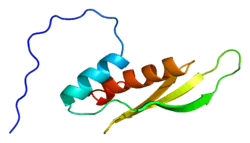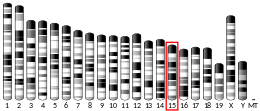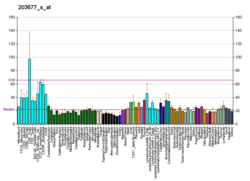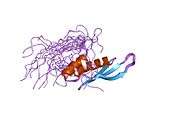TARBP2
RISC-loading complex subunit TARBP2 is a protein that in humans is encoded by the TARBP2 gene.[5][6]
Function
HIV-1, the causative agent of acquired immunodeficiency syndrome (AIDS), contains an RNA genome that produces a chromosomally integrated DNA during the replicative cycle. Activation of HIV-1 gene expression by the transactivator Tat is dependent on an RNA regulatory element (TAR) located downstream of the transcription initiation site. The protein encoded by this gene binds between the bulge and the loop of the HIV-1 TAR RNA regulatory element and activates HIV-1 gene expression in synergy with the viral Tat protein. Alternative splicing results in multiple transcript variants encoding different isoforms. This gene also has a pseudogene.[6]
Interactions
TARBP2 has been shown to interact with Protein kinase R[7][8] and RBM14.[9]
References
- GRCh38: Ensembl release 89: ENSG00000139546 - Ensembl, May 2017
- GRCm38: Ensembl release 89: ENSMUSG00000023051 - Ensembl, May 2017
- "Human PubMed Reference:". National Center for Biotechnology Information, U.S. National Library of Medicine.
- "Mouse PubMed Reference:". National Center for Biotechnology Information, U.S. National Library of Medicine.
- Gatignol A, Buckler-White A, Berkhout B, Jeang KT (Mar 1991). "Characterization of a human TAR RNA-binding protein that activates the HIV-1 LTR". Science. 251 (5001): 1597–600. doi:10.1126/science.2011739. PMID 2011739.
- "Entrez Gene: TARBP2 Tar (HIV-1) RNA binding protein 2".
- Cosentino GP, Venkatesan S, Serluca FC, Green SR, Mathews MB, Sonenberg N (Oct 1995). "Double-stranded-RNA-dependent protein kinase and TAR RNA-binding protein form homo- and heterodimers in vivo". Proceedings of the National Academy of Sciences of the United States of America. 92 (21): 9445–9. doi:10.1073/pnas.92.21.9445. PMC 40818. PMID 7568151.
- Daher A, Longuet M, Dorin D, Bois F, Segeral E, Bannwarth S, Battisti PL, Purcell DF, Benarous R, Vaquero C, Meurs EF, Gatignol A (Sep 2001). "Two dimerization domains in the trans-activation response RNA-binding protein (TRBP) individually reverse the protein kinase R inhibition of HIV-1 long terminal repeat expression". The Journal of Biological Chemistry. 276 (36): 33899–905. doi:10.1074/jbc.M103584200. PMID 11438532.
- Iwasaki T, Chin WW, Ko L (Sep 2001). "Identification and characterization of RRM-containing coactivator activator (CoAA) as TRBP-interacting protein, and its splice variant as a coactivator modulator (CoAM)". The Journal of Biological Chemistry. 276 (36): 33375–83. doi:10.1074/jbc.M101517200. PMID 11443112.
Further reading
- Cosentino GP, Venkatesan S, Serluca FC, Green SR, Mathews MB, Sonenberg N (Oct 1995). "Double-stranded-RNA-dependent protein kinase and TAR RNA-binding protein form homo- and heterodimers in vivo". Proceedings of the National Academy of Sciences of the United States of America. 92 (21): 9445–9. doi:10.1073/pnas.92.21.9445. PMC 40818. PMID 7568151.
- Kozak CA, Gatignol A, Graham K, Jeang KT, McBride OW (Jan 1995). "Genetic mapping in human and mouse of the locus encoding TRBP, a protein that binds the TAR region of the human immunodeficiency virus (HIV-1)". Genomics. 25 (1): 66–72. doi:10.1016/0888-7543(95)80110-8. PMID 7774957.
- Gatignol A, Buckler C, Jeang KT (Apr 1993). "Relatedness of an RNA-binding motif in human immunodeficiency virus type 1 TAR RNA-binding protein TRBP to human P1/dsI kinase and Drosophila staufen". Molecular and Cellular Biology. 13 (4): 2193–202. doi:10.1128/mcb.13.4.2193. PMC 359540. PMID 8455607.
- Gatignol A, Duarte M, Daviet L, Chang YN, Jeang KT (1996). "Sequential steps in Tat trans-activation of HIV-1 mediated through cellular DNA, RNA, and protein binding factors". Gene Expression. 5 (4–5): 217–28. PMID 8723388.
- Kasof GM, Goyal L, White E (Jun 1999). "Btf, a novel death-promoting transcriptional repressor that interacts with Bcl-2-related proteins". Molecular and Cellular Biology. 19 (6): 4390–404. doi:10.1128/mcb.19.6.4390. PMC 104398. PMID 10330179.
- Daviet L, Erard M, Dorin D, Duarte M, Vaquero C, Gatignol A (Apr 2000). "Analysis of a binding difference between the two dsRNA-binding domains in TRBP reveals the modular function of a KR-helix motif". European Journal of Biochemistry / FEBS. 267 (8): 2419–31. doi:10.1046/j.1432-1327.2000.01256.x. PMID 10759868.
- Duarte M, Graham K, Daher A, Battisti PL, Bannwarth S, Segeral E, Jeang KT, Gatignol A (2001). "Characterization of TRBP1 and TRBP2. Stable stem-loop structure at the 5' end of TRBP2 mRNA resembles HIV-1 TAR and is not found in its processed pseudogene". Journal of Biomedical Science. 7 (6): 494–506. doi:10.1007/bf02253365. PMID 11060498.
- Siffroi JP, Pawlak A, Alfonsi MF, Troalen F, Guellaen G, Dadoune JP (Mar 2001). "Expression of the TAR RNA binding protein in human testis". Molecular Human Reproduction. 7 (3): 219–25. doi:10.1093/molehr/7.3.219. PMID 11228241.
- Daher A, Longuet M, Dorin D, Bois F, Segeral E, Bannwarth S, Battisti PL, Purcell DF, Benarous R, Vaquero C, Meurs EF, Gatignol A (Sep 2001). "Two dimerization domains in the trans-activation response RNA-binding protein (TRBP) individually reverse the protein kinase R inhibition of HIV-1 long terminal repeat expression". The Journal of Biological Chemistry. 276 (36): 33899–905. doi:10.1074/jbc.M103584200. PMID 11438532.
- Iwasaki T, Chin WW, Ko L (Sep 2001). "Identification and characterization of RRM-containing coactivator activator (CoAA) as TRBP-interacting protein, and its splice variant as a coactivator modulator (CoAM)". The Journal of Biological Chemistry. 276 (36): 33375–83. doi:10.1074/jbc.M101517200. PMID 11443112.
- Bannwarth S, Talakoub L, Letourneur F, Duarte M, Purcell DF, Hiscott J, Gatignol A (Dec 2001). "Organization of the human tarbp2 gene reveals two promoters that are repressed in an astrocytic cell line". The Journal of Biological Chemistry. 276 (52): 48803–13. doi:10.1074/jbc.M104645200. PMID 11641396.
- Xu YC, Wu RF, Gu Y, Yang YS, Yang MC, Nwariaku FE, Terada LS (Aug 2002). "Involvement of TRAF4 in oxidative activation of c-Jun N-terminal kinase". The Journal of Biological Chemistry. 277 (31): 28051–7. doi:10.1074/jbc.M202665200. PMID 12023963.
- Battisti PL, Daher A, Bannwarth S, Voortman J, Peden KW, Hiscott J, Mouland AJ, Benarous R, Gatignol A (Sep 2003). "Additive activity between the trans-activation response RNA-binding protein, TRBP2, and cyclin T1 on HIV type 1 expression and viral production in murine cells". AIDS Research and Human Retroviruses. 19 (9): 767–78. doi:10.1089/088922203769232566. PMID 14585207.
- Lee JY, Kim H, Ryu CH, Kim JY, Choi BH, Lim Y, Huh PW, Kim YH, Lee KH, Jun TY, Rha HK, Kang JK, Choi CR (Jul 2004). "Merlin, a tumor suppressor, interacts with transactivation-responsive RNA-binding protein and inhibits its oncogenic activity". The Journal of Biological Chemistry. 279 (29): 30265–73. doi:10.1074/jbc.M312083200. PMID 15123692.
- Haase AD, Jaskiewicz L, Zhang H, Lainé S, Sack R, Gatignol A, Filipowicz W (Oct 2005). "TRBP, a regulator of cellular PKR and HIV-1 virus expression, interacts with Dicer and functions in RNA silencing". EMBO Reports. 6 (10): 961–7. doi:10.1038/sj.embor.7400509. PMC 1369185. PMID 16142218.
- Rual JF, Venkatesan K, Hao T, Hirozane-Kishikawa T, Dricot A, Li N, Berriz GF, Gibbons FD, Dreze M, Ayivi-Guedehoussou N, Klitgord N, Simon C, Boxem M, Milstein S, Rosenberg J, Goldberg DS, Zhang LV, Wong SL, Franklin G, Li S, Albala JS, Lim J, Fraughton C, Llamosas E, Cevik S, Bex C, Lamesch P, Sikorski RS, Vandenhaute J, Zoghbi HY, Smolyar A, Bosak S, Sequerra R, Doucette-Stamm L, Cusick ME, Hill DE, Roth FP, Vidal M (Oct 2005). "Towards a proteome-scale map of the human protein-protein interaction network". Nature. 437 (7062): 1173–8. doi:10.1038/nature04209. PMID 16189514.
- Bannwarth S, Lainé S, Daher A, Grandvaux N, Clerzius G, Leblanc AC, Hiscott J, Gatignol A (Feb 2006). "Cell-specific regulation of TRBP1 promoter by NF-Y transcription factor in lymphocytes and astrocytes". Journal of Molecular Biology. 355 (5): 898–910. doi:10.1016/j.jmb.2005.11.026. PMID 16343534.
- Christensen HS, Daher A, Soye KJ, Frankel LB, Alexander MR, Lainé S, Bannwarth S, Ong CL, Chung SW, Campbell SM, Purcell DF, Gatignol A (May 2007). "Small interfering RNAs against the TAR RNA binding protein, TRBP, a Dicer cofactor, inhibit human immunodeficiency virus type 1 long terminal repeat expression and viral production". Journal of Virology. 81 (10): 5121–31. doi:10.1128/JVI.01511-06. PMC 1900231. PMID 17360756.






